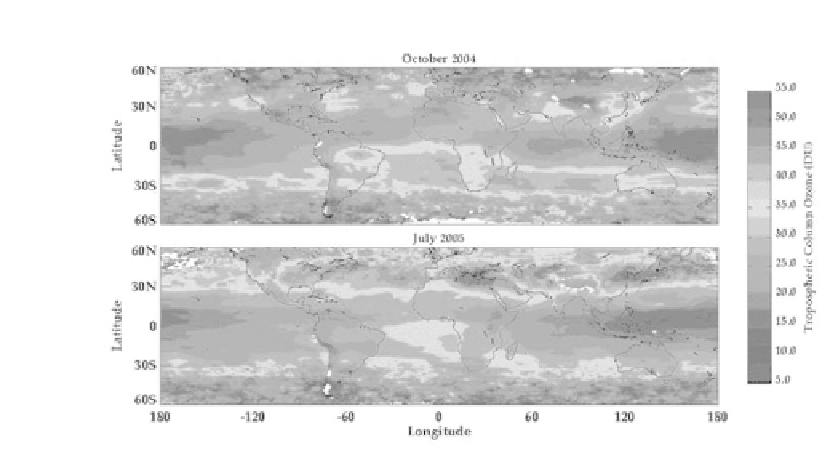Geoscience Reference
In-Depth Information
Figure 6.
These images reflect relative ozone concentration in the middle troposphere, about 3-8
miles above the Earth's surface. Red indicates higher concentrations, and purple indicates lower
concentrations. It remains challenging to extend these data to layers closer than about 1 mile above
the surface, but these images illustrate the major sources and general movement patterns of ozone,
which blankets areas for up to thousands of miles. Short-term experimental global forecasts of
surface-level ozone are available at http://gems.ecmwf.int/d/products/grg/realtime/daily_fields/.
Source
:
NASA
On the basis of what he's seen so far, Keating says satellites just might pan out for
the EPA in terms of monitoring air pollution. “I think there are some potential national
applications. But it's still in the developmental process.”
Part of that process includes plans by NASA, ESA, and others for about a dozen
new satellites in various stages of conceptualization, planning, or design that would
include air pollutant--tracking instruments. These could be launched anytime from
2009 to 2020 and beyond, and could replace and possibly improve upon the current
fl eet of at least nine satellites that track pollutants. Keating says the EPA is currently
talking with NASA about specifi c pollutant tracking needs.
Nonetheless, competing interests and funding limitations may hinder the growth of
the Earth-observation fi eld, including pollutant-tracking efforts. On January 14, 2004
President Bush announced “a new vision for the Nation's space exploration program,”
emphasizing human and unmanned exploration of our solar system. Much of the initial
focus is on returning to the moon and staying for extended periods, then going to Mars
and eventually elsewhere. Little additional money has been budgeted for these proj-
ects so far, so the funds will come primarily out of existing NASA programs. “Earth
science is a little on the back burner,” says Schoeberl. “NASA isn't quite sure what it
wants to do [given] the White House's new focus on Mars.”
With launch dates for satellites routinely being pushed back years at a time, and
with changing government priorities, Keating says the current fl eet may be as good as
it gets. “We're already in the golden age of atmospheric chemistry information,” he
















